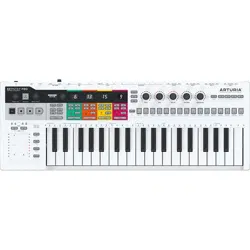Loading ...
Loading ...
Loading ...

5.4. The Drum Sequencer
The Drum sequencer on Track 1 is a special case. It has 24 parallel tracks, but unlike the
other sequencer tracks, each drum track can only trigger one specific drum or percussion
sound.
Also, programming a Drum Pattern is different from programming a melodic sequence. In
sequencer Quick Edit mode, you hold down a step button and then select the notes you want
to include in that step by pressing keys on the keyboard. The Drum sequencer works the
other way around: you hold down a key on the keyboard that triggers a certain drum sound
and then select the step or steps in which that sound will be triggered.
Why then do we have poly(phonic) and mono(phonic) options for a drum track? In Poly
mode, each of the 24 tracks can be different in length. For example, Track 1 could be 8 beats
long; Track 7, 9 beats long and Track 12, 16 beats long. You guessed it: when patterns of
different lengths run in parallel, some very interesting polyrhythmic effects can be created.
That's what Poly means for a Drum Pattern.
In Mono mode, however, all 24 Drum tracks have the same length.
!: Knowing this, you can do some very weird and wonderful things, like creating several tracks with
unequal lengths. Run them until they reach complete chaos, then suddenly switch to Mono mode and
have them all line-up!
5.4.1. Drum vs. Seq Comparison
Seq1/Seq2/Seq3/Seq4 and Drum on Track 1 may seem similar, but the Drum sequencer is
different in many ways:
• Drum mode can record trigger patterns for up to 24 different drum sounds.
• Each of the 24 drum sounds has its own track. When a track is selected, the
step buttons display the Pattern events for that drum. This is similar to the classic
workflow of early drum machines.
• The lower eight keys of the keyboard send gate on/off signals in real time to the
Drum Gates 1-8 outputs on the back panel, as well as any Drum sequencer events
previously entered by those keys. Pressing one of the lower eight keys will select
the corresponding Drum track and generate a trigger. In Drum mode, the higher
keys have no effect. The output from all 24 drum tracks is also sent over MIDI
(Out 1, Out 2 and USB).
• in Drum mode, the Pitch encoder has no effect. The other encoders can be used
to edit gate time and velocity, to shift the timing of drum triggers backward or
forward in relation to the beat grid, and to add randomness of trigger probability
to each drum step.
• The step-mode Shift functions can add many interesting changes to your Drum
sequence:
◦ Invert will reverse the steps of the currently selected Drum instrument
track.
◦ Nudge left and nudge right will shift the position of all steps of the
currently selected Drum instrument track one step to the left or the
right.
◦ Rand Order (Random Order) will mess up the order of the steps in
your drum track.
• The Drum sequencer has a polymeter feature (described in the next section) that
allows each drum track within a Drum Pattern to have its own length.
• Unlike Sequencer tracks, Drum tracks cannot be transposed using the Transpose
button.
92 Arturia - User Manual Keystep Pro - Making Tracks
Loading ...
Loading ...
Loading ...
